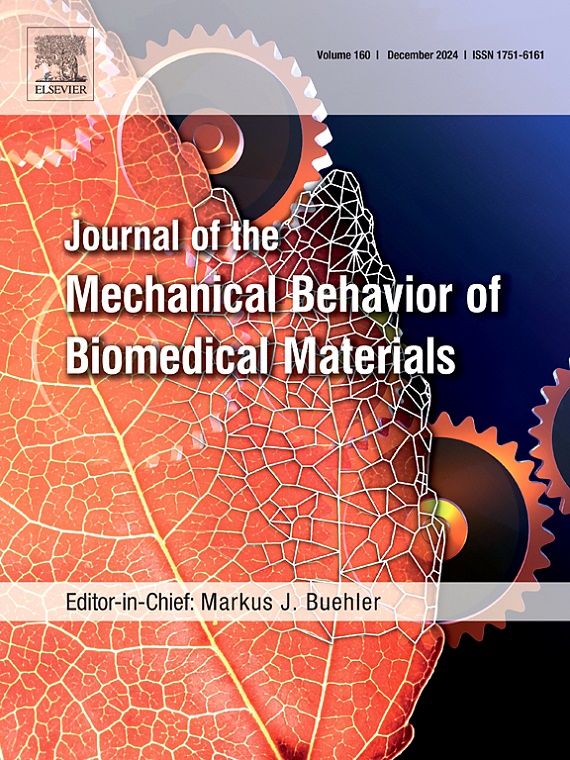绿色合成高性能皮肤创面敷料用PVA-LS-MXene复合导电水凝胶
IF 3.5
2区 医学
Q2 ENGINEERING, BIOMEDICAL
Journal of the Mechanical Behavior of Biomedical Materials
Pub Date : 2025-06-19
DOI:10.1016/j.jmbbm.2025.107107
引用次数: 0
摘要
聚乙烯醇(PVA)基水凝胶已被证明具有良好的生物相容性和亲水性。然而,它们有限的机械弹性和抗菌性能极大地限制了它们在高级伤口护理应用中的效用。为了解决这些关键的限制,我们通过将木质素(LS)和MXene纳米片战略性地掺入PVA基质中,构建了一种导电复合水凝胶作为潜在的伤口敷料。这种三元体系通过非共价相互作用建立了强大的分子间网络,有效克服了传统水凝胶敷料机械性能不足和抗菌功效不足的历史挑战。复合水凝胶的抗拉强度可达340.8 kPa,断裂伸长率可达239.9%,压缩模量大于0.41 MPa。同时,复合水凝胶具有良好的抗菌活性和生物相容性,有助于减少伤口感染,促进伤口愈合。此外,PLM复合水凝胶在小鼠伤口模型中显著加速伤口愈合。在这项工作中,一种环境友好的PLM复合膜通过协同整合抗氧化、抗炎和导电特性,展示了多功能治疗潜力,为感染和受损的皮肤提供了有效的多模式治疗。本文章由计算机程序翻译,如有差异,请以英文原文为准。

Green synthesis of PVA-LS-MXene composite conductive hydrogel for high-performance skin wound dressings
Polyvinyl alcohol (PVA)-based hydrogels have been demonstrated to possess excellent biocompatibility and hydrophilicity. Nevertheless, their restricted mechanical resilience and antimicrobial properties have substantially constrained their utility in advanced wound care applications. To address these critical limitations, we constructed a conductive composite hydrogel as a potential wound dressing through strategic incorporation of lignin (LS) and MXene nanosheets into a PVA matrix. This ternary system establishes robust intermolecular networks via non-covalent interactions, effectively overcoming the historical challenges of inadequate mechanical performance and insufficient antimicrobial efficacy in conventional hydrogel dressings. The composite hydrogel displays high tensile strength (up to 340.8 kPa), elongation at break of up to 239.9 %, and compression modulus of more than 0.41 MPa. Meanwhile, the composite hydrogel exhibits excellent antimicrobial activity and biocompatibility, which helps to minimize wound infections and promote wound healing. Furthermore, the PLM composite hydrogel markedly accelerated wound healing in a mouse wound model. In this work, an environmentally benign PLM composite membrane demonstrated multifunctional therapeutic potential through synergistic integration of antioxidant, anti-inflammatory, and electroconductive properties, offering an efficacious multimodal therapy for infected and damaged skin.
求助全文
通过发布文献求助,成功后即可免费获取论文全文。
去求助
来源期刊

Journal of the Mechanical Behavior of Biomedical Materials
工程技术-材料科学:生物材料
CiteScore
7.20
自引率
7.70%
发文量
505
审稿时长
46 days
期刊介绍:
The Journal of the Mechanical Behavior of Biomedical Materials is concerned with the mechanical deformation, damage and failure under applied forces, of biological material (at the tissue, cellular and molecular levels) and of biomaterials, i.e. those materials which are designed to mimic or replace biological materials.
The primary focus of the journal is the synthesis of materials science, biology, and medical and dental science. Reports of fundamental scientific investigations are welcome, as are articles concerned with the practical application of materials in medical devices. Both experimental and theoretical work is of interest; theoretical papers will normally include comparison of predictions with experimental data, though we recognize that this may not always be appropriate. The journal also publishes technical notes concerned with emerging experimental or theoretical techniques, letters to the editor and, by invitation, review articles and papers describing existing techniques for the benefit of an interdisciplinary readership.
 求助内容:
求助内容: 应助结果提醒方式:
应助结果提醒方式:


